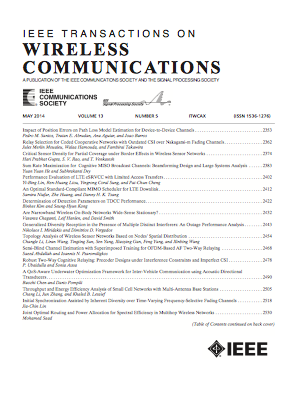天空地一体化网络(SAGIN)的中断概率、性能和公平性分析:无人机高度和位置角度
IF 10.7
1区 计算机科学
Q1 ENGINEERING, ELECTRICAL & ELECTRONIC
引用次数: 0
摘要
由于移动数据流量的爆炸性增长,空间-空-地一体化网络(SAGIN)受到了极大的关注。在该网络中,无人机(uav)作为空中中继节点,桥接地面和空间网络起着至关重要的作用。然而,无人机与卫星之间的动态位角以及无人机的固定高度限制了无人机的空对空传输能力。此外,有限的无人机电池容量在SAGIN传输期间承担能量中断的风险。为了解决这些问题,我们提出了一个考虑无人机信道衰落、能量消耗和收获的集成模型。该模型使我们能够全面分析SAGIN的传输性能。在此框架下,我们计算了SAGIN上行传输的无人机能量中断概率和信噪比中断概率。在对网络性能分析的基础上,导出了保证不间断能量供应和防止信噪比中断的最佳无人机高度表达式。为了评估SAGIN传输性能的公平性,我们比较了地对空和地对空传输的能力。此外,我们还提供了两种情况下传输时间间隔的封闭表达式。数值结果验证了这些推导表达式的准确性,并评估了关键参数如何影响SAGIN上行链路中无人机的最佳高度。本文章由计算机程序翻译,如有差异,请以英文原文为准。
Outage Probability, Performance, and Fairness Analysis of Space–Air–Ground Integrated Network (SAGIN): UAV Altitude and Position Angle
The Space-Air-Ground integrated network (SAGIN) has gained significant attention due to the explosive growth in mobile data traffic. In this network, Unmanned Aerial Vehicles (UAVs) play a critical role as air relay nodes, bridging ground and space networks. However, challenges arise from the dynamic position angles between UAVs and satellites, as well as fixed UAV altitudes, limiting air-to-space transmission capacity. Moreover, the finite UAV battery capacity carries the risk of energy interruptions during SAGIN transmissions. To address these issues, we propose an integrated model that considers UAV channel fading, energy consumption, and harvesting. This model allows us to comprehensively analyze SAGIN transmission performance. Within this framework, we calculate the UAV energy outage probability and signal-to-noise ratio (SNR) outage probability for SAGIN uplink transmission. Based on our network performance analysis, we derive an expression for the optimal UAV altitude, ensuring uninterrupted energy supply and preventing SNR outage. To assess the fairness of SAGIN transmission performance, we compare the capabilities of Ground-to-Air-to-Space and Ground-to-Space transmissions. Additionally, we provide closed-form expressions for the transmission time gap in both scenarios. Our numerical results validate the accuracy of these derived expressions and evaluate how key parameters impact the optimal UAV altitude in the SAGIN uplink.
求助全文
通过发布文献求助,成功后即可免费获取论文全文。
去求助
来源期刊
CiteScore
18.60
自引率
10.60%
发文量
708
审稿时长
5.6 months
期刊介绍:
The IEEE Transactions on Wireless Communications is a prestigious publication that showcases cutting-edge advancements in wireless communications. It welcomes both theoretical and practical contributions in various areas. The scope of the Transactions encompasses a wide range of topics, including modulation and coding, detection and estimation, propagation and channel characterization, and diversity techniques. The journal also emphasizes the physical and link layer communication aspects of network architectures and protocols.
The journal is open to papers on specific topics or non-traditional topics related to specific application areas. This includes simulation tools and methodologies, orthogonal frequency division multiplexing, MIMO systems, and wireless over optical technologies.
Overall, the IEEE Transactions on Wireless Communications serves as a platform for high-quality manuscripts that push the boundaries of wireless communications and contribute to advancements in the field.

 求助内容:
求助内容: 应助结果提醒方式:
应助结果提醒方式:


